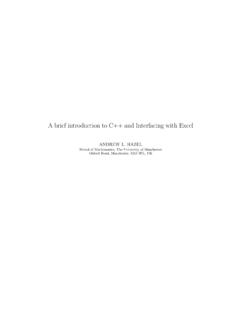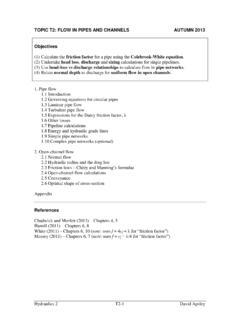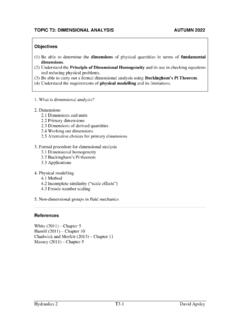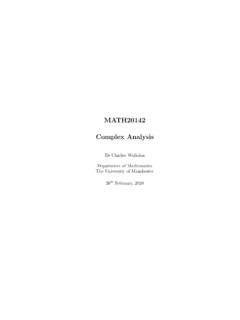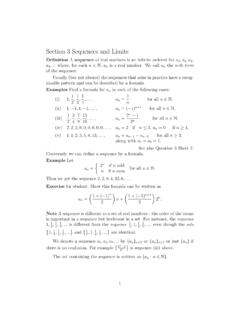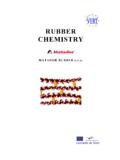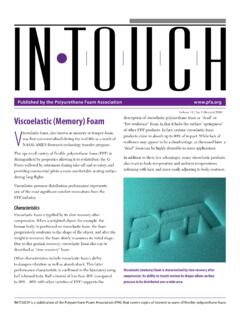Transcription of Fluid Flow Notes
1 Fluid FlowThomas Rodgers2013 ContentsList of FiguresiiiNomenclaturev1 Introduction to Fluid .. is a Fluid ? .. Mechanics .. Flow in Chemical Engineering Applications .. of Fluids ..62 .. of Pressure with Position in a Fluid at Rest .. Principle .. s Principle .. Measurement Devices .. Barometer .. Bourdon Gauge .. Heads ..233 Flow Dynamics Ideal .. Regimes and Reynolds Number .. Balance in a Pipe .. and Streamtubes .. Continuity Equation .. Balance .. Energy .. Energy .. Energy .. Losses .. s Equation.
2 374 Applications of Bernoulli s from a Tank .. with Constant Height .. with Variable Height .. Measurement .. Profile Measurement The Pitot Tube .. Orifice Meter .. Venturi Meter ..515 Momentum of the Momentum Equation .. of the Momentum Equation .. through a contracting section of pipework or through a nozzle around a contracting pipe bend ..636 Friction Losses - Ideal Balance on Fluid Element .. Pipe Fittings ..73iiList of of a simple chemical process .. and shear stress .. between gauge and absolute pressures .. co-ordinate system, and differential volume element.
3 Principle .. of a barometer .. of a U-tube manometer .. of a compound manometer .. of a Bourdon gauge .. flow in a pipe between tanks at different pressures .. of Fluid flow versus pressure difference .. profiles in pipes under laminar, turbulent and ideal flow .. patterns observed on injection of a stream of dye into a flowing in steady straight flow and approaching a constriction .. through a streamtube .. of Fluid flow along a pipe .. acting against a pressureP1over a distancedlat a velocityu.. discharging through a hole in the base of a tank.
4 Tube .. meter .. meter .. flowing into a tank .. pipe, through which Fluid is flowing .. through a reducing pipe bend .. balance over a control volume .. roughness .. Chart ..70iiiivNomenclatureRomanAAream2aAccele rationm s 2 CDDischarge coefficient DDiametermFForceNfFriction factor gAcceleration due to m s 2hHeightmKNumber of velocity headsmlDistancemmMasskg MMass flow ratekg s 1nMolesmolPPressurePapVapour pressurePaQVolumetric flow ratem3s 1 QHeat lossWRGas J mol 1K 1 ReReynolds numberDu / TTemperatureKtTimesuVelocitym s 1 VVolumem3vVelocitym s 2 WWorkWx x-directionmy y-directionmz z-directionmGreek Surface roughnesscm ViscosityPa s Densitykg m 3 Surface tensionN m 1 wWall shear stressPavviChapter1 Introduction to Fluid
5 Is a Fluid ? .. Mechanics .. Flow in Chemical Engineering Applications .. of Fluids .. IntroductionChemical engineers are frequently interested in systems involving the flow of fluids. Thisinterest occurs at two levels:1. the practical level, in which many of the methodologies for the design of chemicalengineering processes and operations require Fluid flow calculations; and2. the conceptual level, in which Fluid flow illustrates one of the distinctive and defin-ing skills of a chemical engineer, that of being able to take a fundamental under-standing of the physical universe and apply it to solve practical problems in a waythat is both effective and examples of Fluid flow calculations include pipe network design (including siz-ing of pumps and pipelines for transferring fluids within processes)
6 And Fluid flow effectson rates of heat and mass transfer, on reaction rates and on separation , Fluid flow is an example of a transport process, in which the rate of transferof matter or energy depends on physical factors affecting the transfer, such as the physicalproperties of the material under investigation and the geometry of the of the key fundamental ideas needed for Fluid flow are the Conservation Laws, ofwhich the three most important ones are:Conservation of MassConservation of EnergyConservation of Linear Momentum(There are others, notably Conservation of Angular Momentum and Conservation of Elec-tric Charge.)
7 Thanks to Einstein, Mass and Energy are now recognised as equivalent andinterchangeable, such that it is more correct to speak of Conservation of (Mass and En-ergy), but in the absence of nuclear reactions, mass and energy are separately in most cases, and certainly in the case of Fluid Flow, the chemical engineer canassume the laws of Conservation of Mass and Conservation of Energy to apply three conservation laws will form the basis for developing our fundamental under-standing of Fluid Flow, as later on we will employ these fundamental ideas in order toderive the three major mathematical descriptions of Fluid Flow: the Continuity Equation,Bernoulli s Equation, and the Momentum Equation.
8 We will derive these firstly for thesimplified case of Ideal Fluids, then extend the equations to allow us to do useful cal-culations involving Real Fluids. We will illustrate the use of Fluid flow in the contextof chemical engineering using examples relating to flow in pipes and vessels. Before wemove to flowing fluids, we need to have some understanding of the static behaviour of flu-ids, which is the study of Hydrostatics; and before we begin with that, we need to formallyidentify what fluids are and be introduced to some of their important 1. INTRODUCTION TO Fluid What is a Fluid ?
9 Generally, matter exists in many one of four fundamental states (though there are manymore): solid, liquid, gas, or plasma (although materials with intermediate properties exist,in particular, materials that exhibit both solid-like and Fluid -like properties liquidcrystals). A Fluid is a liquid or a gas, which differ from solids in thatFluidsFluids deform continuously under the action of an applied shear : The four common states of shear stress is a force that acts on an area tangential to (as opposed to perpendicularto) the direction of the force. If a shear force is applied to a solid, it may deform a littlefrom its initial position, but it will not continue to do so, and when the force is removed,it will recover its initial shape.
10 By contrast, a Fluid will continue to deform as long as theshearing action is applied, and when the shear force is removed, it will not bounce back toits original position. (A viscoelastic material is in between it will flow to some extent onapplication of a shear force, and will bounce back to some extent, but not completely, onremoval of the applied force. Blu-tack and bread doughs are both examples of viscoelasticmaterials.)Fluids may be subdivided into liquids and gases (and plasma), which differ from eachother in several distinctive ways. The molecules in liquids stick closely together such thatliquids have a definite volume and will not fill a container having a larger volume.

